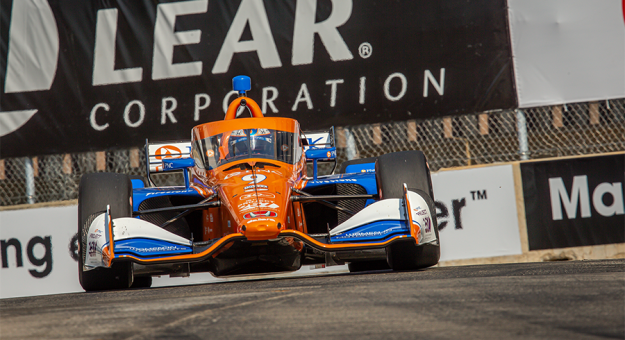DETROIT — The Chevrolet Detroit Grand Prix may be an instant hit for downtown Detroit, but the race course itself remains a work in progress.
IndyCar officials made some changes to the nine-turn, 1.645-mile temporary street course Friday night to help improve what is a very tight and bumpy course.
SPEED SPORT obtained a memo that was released from the teams to detail the changes to the circuit.
The following changes were made:
• Pit Exit – the POC line was shortened approximately three feet. The line delineating the pit lane from the racetrack was angled approximately three feet closer to driver’s right. All procedures as explained during the Competition meeting remain in effect.
• Turn 1 – a single row of tires was removed from the Turn 1 exit. The circle indicates the area that was changed.
• Start Zone – Cones have been placed on both sides of the track to indicate the approximate area where the pole winner will start the race (St. Antoine & East Jefferson Ave.) The starter’s stand is located driver’s left at approximately the intersection of Beaubien Blvd. and East Jefferson Ave. Approximate starter’s stand location circled in blue.
• Pit In – A banner was installed at the pit in attenuator to increase visibility.
• Pace Car – The Pace Car will be staged and dispatched from driver’s left at Turn 9.
The changes were made to help improve racing on what is an extremely tight race course.
According to one driver who competes for one of the top teams in the series following Saturday morning’s practice, “This is not a street course. This is a go-kart track where you would come after drinking beer and racing with your buddies. But it is not a race course.”
Other drivers voiced complaints about the course, comparing it to the bumpy and challenging street course used for the Big Machine Music City Grand Prix in Nashville.
Kyle Moyer, the IndyCar team manager at Team Penske, told SPEED SPORT that traction will be the key to success in Sunday’s race. Because mechanical grip is more important than aerodynamic downforce, that will have to be accomplished by using the dampers to handle the racing surface.
Dampers are shock absorbers and a key part of the car’s overall handling.
Arrow McLaren Racing Director Gavin Ward told SPEED SPORT that the course is the same for everyone and “they will figure it out.”
Saturday morning’s practice session was frustrating for many drivers because with 27 cars on such a short street course, there is one car for every 300 feet of track. Many drivers were not able to get a clean lap during Saturday’s final practice session before qualifications.
Scott Dixon of Chip Ganassi Racing was the fastest driver in Saturday’s session with a lap at 1:03.2317 for a speed of 93.656 miles per hour in the No. 9 PNC Bank Honda for Chip Ganassi Racing. Team Penske’s Will Power was second at 1:03.4627 (93.315 mph) in the No. 12 Verizon Chevrolet.
Kyle Kirkwood of Andretti Autosport was third at No. 27 AutoNation Honda at 1:03.5658 (93.163 mph) followed by Alex Palou of Chip Ganassi Racing, 1:03.7165 mph in the No. 10 Honda and Scott McLaughlin of Team Penske, 1:03.7166 (92.943 mph) in the No. 3 Chevrolet.
Qualifications for Sunday’s race are Saturday at 1:20 p.m. Eastern Time.
